(Photo by Russell Lansford/Icon Sportswire)
The Atlanta Braves are off to a great start and are one of the most potent offenses in 2018. It’s early and not much is expected from Atlanta this year; the Braves probably weren’t supposed to be this effective at the plate until the top prospect in baseball, Ronald Acuna, arrived and cemented his place in the lineup. The hottest hitter on the team is infielder Ozzie Albies.
Those paying close attention to the Braves’ farm system shouldn’t be surprised at how well Albies has been hitting. The captivating aspect to his start has been his slugging with a .391 ISO, well ahead of any hitter on the Braves roster. Will Albies continue his power hitting? His 180 wRC+ is very hard to maintain, so how far will that number drop? Could he turn out to be the best overall hitter on a team that already has the prolific Freddie Freeman?
The first question is competition level; is he facing lesser teams and/or pitchers? Just under half of Atlanta’s games thus far have been against presupposed National League East champions, the Washington Nationals. They’ve split the early portion of the series 3-3 with 27-24 run total favoring the Braves. The Nationals currently have the best and worst success against Albies in respect to pitchers. Albies has six at-bats each against Washington starters AJ Cole and Max Scherzer. Below is the pitches Albies faced against Cole, whom he is 3 for 6 against.
These are two image gifs representing both at-bats for Albies against Cole (top chart) and Scherzer (bottom); images display all pitches from the two games apiece versus the Braves. You can get a sample of how a power pitcher (Scherzer) and a finesse pitcher (Cole) have attacked Albies in 2018. In terms of pitching type, Albies hits both relatively the same; .860 OPS versus power pitchers and .880 against finesse, though with much more power.
The duo drew contact low in the zone six of seven events. It should be noted that both pitchers are also right-handed; more on that in a minute.
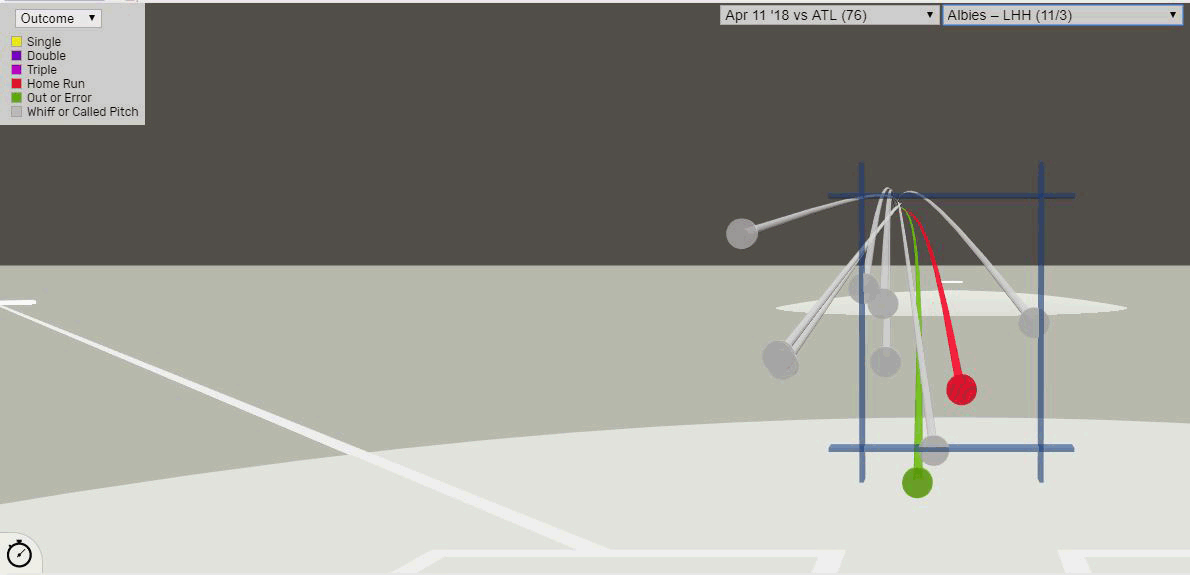
Cole allowed two singles and a home run in 6 at-bats.
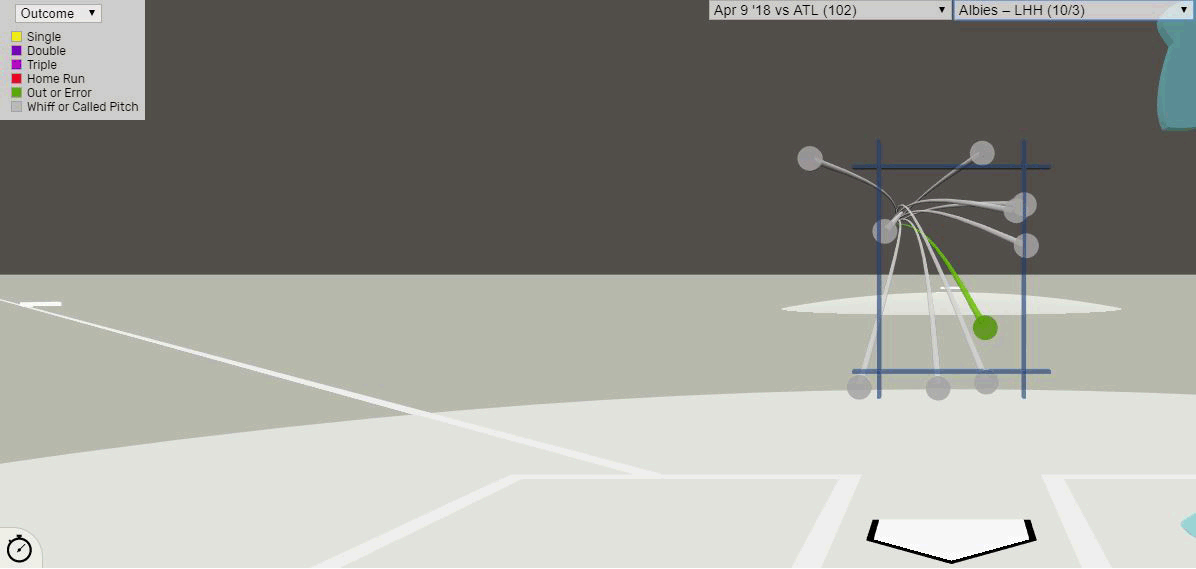
Scherzer has kept Albies in check; 0 for 6.
This has been the case thus far; Albies is a switch hitter and as a lefty versus right-handed pitching he’s hitting .258 through 68 career games. Conversely, he’s eating up left-handed pitches from the right side of the plate, hitting .397 in 40 games. In 2018, the time frame we’re focusing on, Albies has faced far more righties. Yet, he’s been so good against left-handed pitching, that it balances out any detriments to his season totals. Basically, if you’re a lefty finesse pitcher facing Albies I wish you luck.
Well then, is Albies a lucky hitter thus far? His expected batting average is .041 lower than his actual average; 65th biggest difference overall in 2018. Albies BABIP sits at .313, pretty close to league average so there is a minuscule amount of luck involved in Albies’ early success. Albies is a fast runner and speed helps out in terms of BABIP when it comes to ground balls. However, Albies’ GB% is actually 5% lower in 2018 than his sneak-peak in 2017. He’s already hit five home runs in 2018 after hitting only 6 in three times as many games in 2017; a third of how many he hit in the minors since 2016. Through that time period, Albies had 963 at-bats; a very small home run ratio. So what can we make of his early power? Is it sustainable?
While not exactly a reliable assessment, he’s hit just one home run in all his spring training experience. I bring this up because you could deduce that pitching quality is lower and perhaps giving Albies more of an opportunity to square up on pitches. If his power was for real, wouldn’t we be seeing it more in not only spring training but in the minors as well? It’s just not there.
Scouts graded out Albies at a 65 contact rating with a 45 power rating. Don’t let that fool you into thinking that Albies is nothing more than a slap hitter; he’s got power behind his contact (as we’ll see momentarily). However, Baseball American scouting report listed his biggest weakness as such:
…there is very likely going to be an adjustment period with the bat, particularly when facing right-handers.
And that’s somewhat been the case so far. As we found out early, he’s worse against righties…but not that much worse early in his career. He’s faced half as many southpaws as he has righties but his OPS against the latter is a decent .753.
So where has this burst of power come from? My initial assessment is he’s adjusted his swing path and become a probationary member of the fly ball club.
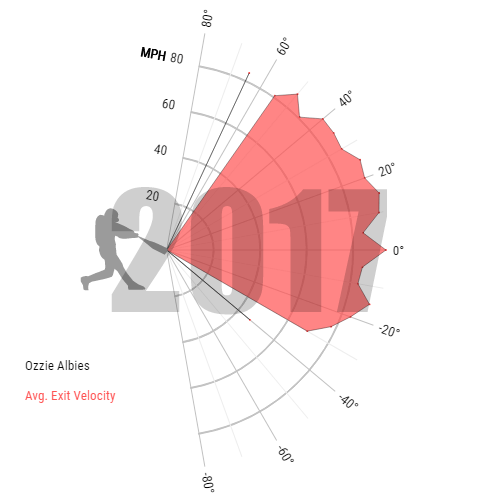
Not conclusive but there is a potential for the tendency, so long as the exit velocity is able to be maintained.
As mentioned, Albies groundball rate decrease of 5% has been compensated by a larger fly ball rate. Also to consider is his Z-Swing rate is up slightly (improved eye?) while his hard-hit rate is slightly lower. Whats more is through the start of the 2018 season, Albies HR/FB rate is at 21%.
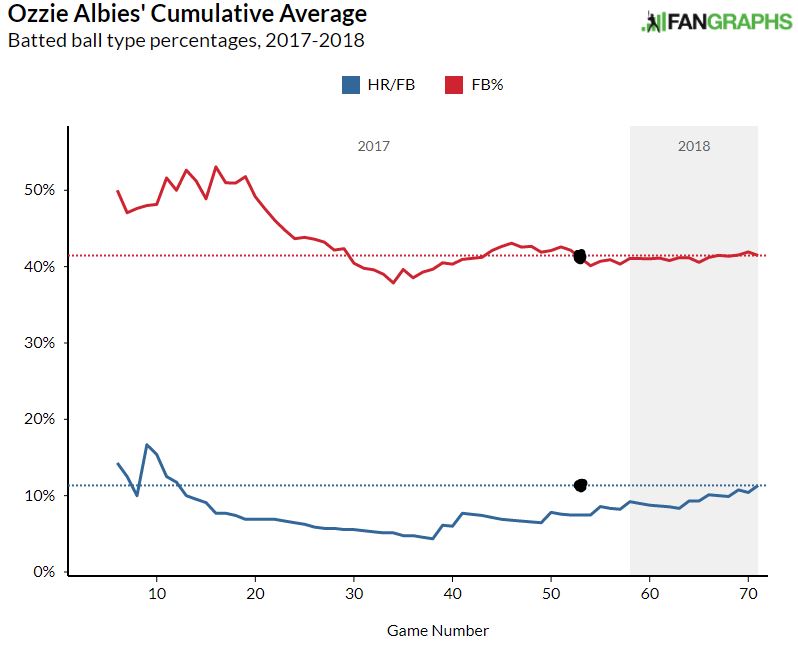
I’m going to project that Albies’ fly balls have reached stabilization since game 54 (sloppy black dot), even as early as game 42. From that point on, you can see that his HR/FB rate has been slowly improving.
So let us see the data when it comes to Albies’ home runs. We’ll check average distance, launch angle, and exit velocity for both 2017 and 2018.

OK, home run distance is over 15 feet further; reinforcing his ability to hit with hard contact. It would also appear that his swing plane has straightened out a bit with his 2-degree launch angle difference. No deviation from exit velocity.
This is further exemplified in the chart below. Slight adjustments in LA and EV, but again, hit distance is much further.

Hits under those metrics, for league average, result in 84% singles with a .980 batting average. You would guess that a player like that is a good contact hitter, not one with pop.
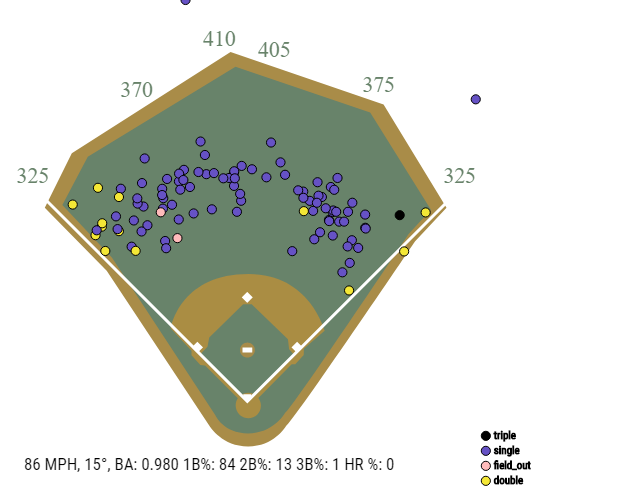
He’s 21 and has some room to grow, strength-wise. Albies is listed at 5’9″ and 160 lbs. I’m no fitness expert but Albies looks very lean, so I’d assume roughly 10% body fat. Using this site’s formula, the best we could expect Albies to be is roughly 170 with 160 pounds accounting for lean mass. The makeup of a power hitter is usually something like 6 feet and 195 pounds. Of the top 30 in career ISO, the smallest of the group is Willie Mays coming in at 5’11 and 180. We cannot expect Albies to be a power hitter and this run is likely nothing more than a hot start. Conversely, he’s demonstrating the potential to hit 30 home runs; much better than his projection 15-ish.
Again, we have such a small sample to work with but its clear Albies has made adjustments. Given his metrics and details from his scouting report, its hard to say if the power is for real. No one will deny Albies will hit for average but the unexpected home run streak could make him a much more dynamic player. Would it be hard to think that Albies is the future of the Braves and not top prospect Acuna? That’s a bold statement but I have to consider him a way-too-early dark horse candidate for National League MVP. The hits will be there, I just can’t buy into the power.

I have seen a lot of Albies good hits – he is just barreling them. He reminds me of Lindor when Lindor is hitting for power. When he gets a pitch to hit he has been right on it and has been lining them into the seats. If he can square up balls like he has over the last week, then he is a superstar. Perhaps I could describe it is instead of trying to hit LD he is trying to hit FB? I know that doesn’t exactly bare itself out in the underlying numbers, but I will assert that maybe he is toeing the line between FB and LD – that’s what it looks like to me – high LDs and low FBs. You are probably wondering if I think it is sustainable… I don’t know – doubt it as that seems like an awfully narrow band. If he is lucky, those FB turn into LDs and not cans of corn because he doesn’t have the pop to make those play.
Excellent points. Thanks for the feedback!
Something I didn’t mention is Albies’ 2018 IFFB rate; 1.4% last season, up to 12.5% this season. He’s definitely trying to hit fly balls and get them over the fence.
In terms of line drives, his contact in that respect has remained stable.
Great stuff guys! I just thoroughly enjoyed announcing his full name in the seventh round of our draft and looking around at the blank faces (we drafted March 30).
Haha, great name, right?
Thanks for the compliment, Maris!
Great article! Albies is a beast. I am surprised nobody is making comparisons to Jimmy Rollins, a 5’7″ switch hitting middle infielder who averaged 36 2B, 9 3B and 15 HRs a season over his career and also had quite a few 20+ HR seasons. Ablies was posting workout pics on instagram over the offseason and the dude is seriously pure muscle. That power is for real, though he has to be overachieving a bit right now. He is on pace to hit 58 HR and 93 2B.
Right on the Rollins point. Albies is definitely working hard to be a star.
Thanks for the comment!
Fantastic breakdown, thank you for doing these!
Thank you for reading!